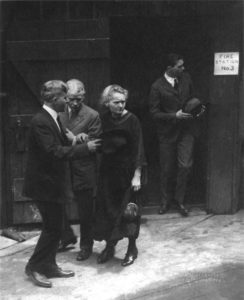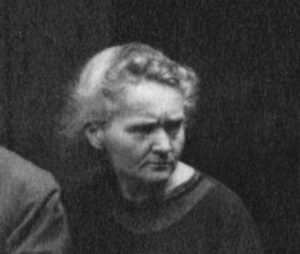By Jeffrey Mifflin

Photograph by N.M. Jeannero, Pittsburgh Sun, 1921
Until recently, a vintage photograph in an old frame at the Massachusetts General Hospital Archives bore the caption, “Pierre Curie and Marie Curie Visiting America, ca. 1903.” The caption caught my attention and aroused my suspicions when I unframed the picture to facilitate its reproduction. Wasn’t Marie’s first visit to the United States much later? And hadn’t Pierre’s head been tragically crushed beneath the wheel of a horse-drawn vehicle long before then? Library sleuthing furnished the correct place and date for the photograph, provided background details, and explained some (but not all) of the intriguing circumstances surrounding the image, which originally hung in Mass General’s radiology department.
The discovery of radioactivity, a landmark in the history of science, earned Marie Curie, her husband, Pierre Curie, and Henri Becquerel the Nobel Prize in Physics in 1903. In the course of her research Marie discovered the elements polonium and radium. Radium is a radioactive decay product of uranium; both elements are found in uraninite (a mineral formerly known as “pitchblende”). The extraction of radium was an extremely laborious process.
Over the years Marie Curie gave away bits of radium on numerous occasions so that cancer patients could be treated. But by 1920 she was without means to acquire more of the difficult-to-obtain substance. An American newspaper woman, Mrs. W. B. Meloney, interviewed Curie at her Paris laboratory and learned that what she wanted most was more radium to continue her research. The cost of one gram of radium in 1920 was $100,000. Meloney raised the prodigious sum in less than a year, primarily through small donations and with the help of many American women. On May 3, 1921, the Marie Curie Radium Fund Committee awarded a contract to the Standard Chemical Company of Pittsburgh to extract a gram of radium.
Curie embarked for the United States to accept the gift, arriving in New York City (amid much fanfare) in May 1921 aboard the RMS Olympic with her daughters, Irène and Ève. She was in her early fifties, and it was her first trans-Atlantic trip. Her visit to the Canonsburg Plant of Standard Chemical that May was documented by a number of photographs. The image seen here shows her talking with two men, who seem to be escorting her around the industrial facility. They are presumably scientists or managers—not Pierre Curie, as the original caption indicated—working for the company.
The signal event of the American trip came when Curie was honored at the White House on May 20, 1921. President Warren G. Harding handed her the newly extracted radium (contained in a vial in a lead-lined mahogany box) during a ceremony before a group of admiring dignitaries. In a speech following the radium presentation, Harding welcomed Madame Curie on behalf of the American people: “As a nation whose womanhood has been exalted to fullest participation in citizenship, we are proud to honor in you a woman whose work has earned universal acclaim and attested woman’s equality in every intellectual and spiritual activity. . . . We greet you as foremost among scientists in the age of science. . . .”
 Historical research revealed correctable errors in the original caption. But one lingering mystery remains. Why does the renowned guest have such an acerbic look on her face? Did she recoil from the intrusion of pesky photographers? Was she disturbed by some incident outside the camera’s field of vision? Or had too much exposure to radioactivity (a word she coined) already affected her health and disposition?
Historical research revealed correctable errors in the original caption. But one lingering mystery remains. Why does the renowned guest have such an acerbic look on her face? Did she recoil from the intrusion of pesky photographers? Was she disturbed by some incident outside the camera’s field of vision? Or had too much exposure to radioactivity (a word she coined) already affected her health and disposition?
Jeffrey Mifflin is the archivist of Massachusetts General Hospital.
